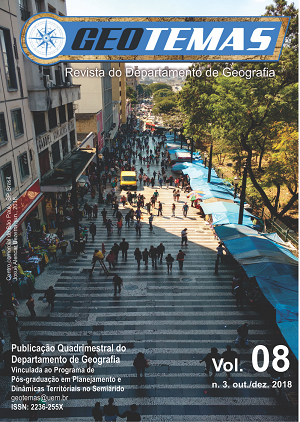The embroidery industry and the production of urban space in Maranguape - CE
Keywords:
Industry, Space, GeographyAbstract
It is in the district of Sapupara in Maranguape - CE that we look for the Embroidery Industry and its interweaving with the cultural and economic dimension. We aim to analyze the production of the embroidery and the social, economic and, especially, the urban space of the municipality of Maranguape, and also to understand the relations of production and work in the cooperative under study; to investigate the profile of embroiderers and their spatialization in the Municipality of Maranguape and to identify the spatialization of embroidery production in the municipality and the flows that drive (Production, distribution, commercialization, consumption). For that, the following methodological course was drawn: Bibliographic survey; documentary and statistical analysis; field work and semi-structured interviews, preparation of cartographic material, tabulation of data, systematization and analysis of all collected material. It was possible to understand the importance of embroidery in Maranguape, both for its affective and cultural value as well as for its economic value. It is also possible to see how the insertion of women in labor corroborates the maintenance of the hegemony of the capitalist system and the existence of this embroidery industry, which represents an articulated whole of the capitalist system, even though governed by the logic of cooperative work, aid and all involved. The importance of this research for Geographic Science is evident, since this activity transforms the geographic space due to the creation of different fixed ones and the impulse of new flows, as the embroiderers that comes from six districts of different districts in the municipality and the public consumer of embroidery from different parts of the national territory.
Downloads
References
AMORA, Z. B. Indústria e espaço no Ceará. In: SILVA, J. B. da.; CAVALCANTE, T. C.; DANTAS, E. W. C. (et al) (orgs.). Ceará: um novo olhar geográfico. Fortaleza: Edições Demócrito Rocha, 2005.
BRASIL. Turismo cultural: orientações básicas. 2. ed. Brasília: Ministério do Turismo, 2008.
CANCLINI, N. G.As culturas populares no capitalismo.São Paulo: Brasiliense, 1983.
CARLOS, A. F. A. Espaço e indústria.São Paulo: Editora Contexto/Edusp, 7. edição 1997.
DAVID, L. M. S. Cooperativismo e Conhecimento Institucional em Cooperativa. Fortaleza: UFC/FEAAC, 2008.
FAJARDO, E.; CALAGE, E.; JOPPERT, G.Fios e Fibras. Rio de Janeiro: Ed. Senac Nacional, 2002.
GALVíO, R. Aracati: Labirinto de Sonhos e de luz. Fortaleza. Edições SEBRAE -Ce, 2006.
HARVEY. D. Condição pós-moderna:uma pesquisa sobre as origens da mudança cultural. São Paulo: Loyola, 1994.
IBGE. IBGE Cidades:Maranguape. Disponível em: <https://cidades.ibge.gov.br/brasil/ce/maranguape/panorama> Acesso em: 17 dez. 2018.
IPECE. Instituto de Pesquisa e Estratégica Econômica do Ceará. Disponível em < http://www.ipece.ce.gov.br/ > Acesso em: 20 abr. 2018.
MENDES, M. C. Metropolização e indústria:Maranguape no contexto da região metropolitana de Fortaleza-CE. Dissertação apresentada No curso de Mestrado Acadêmico em Geografia, pela Universidade Estadual do Ceará –2015. Disponível em: http://www.uece.br/mag/dmdocuments/marilia_colares_dissertacao.pdf Acesso em: 22 fev. 2018.
MUNIZ, A. M. V. A dinâmica da indústria têxtil no espaço metropolitano de Fortaleza. Tese(Doutorado em Geografia). Programa de Pós-Graduação em Geografia,Universidade Federal do Ceará, Fortaleza, 2014.
MUNIZ, A. M. V. Produção do espaço metropolitano de fortaleza e a dinâmica industrial. In: Mercator, Fortaleza, v. 14, n. 3, p. 61-74, set./dez. 2015.
MUNIZ, A. M. V.Ceará state and the textile industry in time-space/o Ceará e a indústria têxtil no espaço-tempo/. In: Boletim Goiano de Geografia(Online), v. 36, p. 420-443, 2016.
OCB/CE -SESCOOP/CE -FECOOP NE. Relatório de Gestão 2014. Disponível em: http://cearacooperativo.coop.br/ftp/Relatorio-de-Gestao-SESCOOP-ce-2014.pdf Acesso em: 11 jan. 2018.
SANTOS, M. C. Do global ao local:a dinâmica da indústria de confecção na Região Metropolitana de Fortaleza -Ceará. XI -Encontro Nacional da Anpege, 2015. Dispinível em http://www.enanpege.ggf.br/2015/anais/arquivos/20/553.pdf Acesso em 10maio 2018.
SANTOS, M. A natureza do espaço:espaço e tempo, razão e técnica. 3. Ed. Huciteo. São Paulo, 1999.
SILVA, E. K. R. Crochê e Richelieu:Traços Culturais no Design Brasileiro. Actas de Diseño. Facultad de Diseño y Comunicación. Universidad de Palermo, 2012. Disponível em: http://fido.palermo.edu/servicios_dyc/encuentro2007/02_auspicios_publicaciones/actas_diseno/articulos_pdf/ADC101.pdf. Acesso em: 13 mar. 2018.
SILVA, E. K. R.Quando a cultura entra na moda: a merdalogização do artesanato e suas repercussões no cotidiano de bordadeiras de Maranguape. 2009. Disponível em http://www.repositorio.ufc.br/bitstream/riufc/1276/1/2009_Dis_EKRSILVA.pdf, Acesso em: 4 jan. 2018.
SEVERINO, A. J. Metodologia do trabalho científico. 24. ed. São Paulo: Cortez, 2007.
SISTEMA OCB. Agenda Institucional do Cooperativismo. Disponível em: <http://www.brasilcooperativo.coop.br/gerenciador/ba/arquivos/agenda_institucional_do_cooperativismo_2015_1.pdf> Acesso em: 11 jan. 2018.
SPOSITO, M. E.B. Capitalismo e Urbanização. São Paulo: Editora Contexto, 15. Ed., 2008.
Downloads
Published
How to Cite
Issue
Section
License
Authors who submit their manuscripts to Geotemas declare that the work is an original article and has not been submitted for publication, in full or in part, in another national or international scientific journal or in another circulation vehicle. The authors also declare that they agree with the transfer of the copyright of the referred article to the magazine Geotemas (University of the State of Rio Grande do Norte), allowing for later publications, as long as the source of its publication is assured. Finally, they assume public responsibility for the article, being aware that any charges arising from a claim by third parties regarding the authorship of the work may apply to them.



















